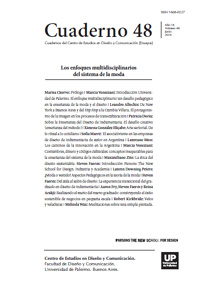Veils and velocities
Resumen
Los lazos de la moda y el entorno son profundos, tectónica y culturalmente.
En la meditación espiritual medieval, la mente era construida en la imagen de una ciudad
amurallada, cuyos edificios estaban “vestidos” de comprensión moral; en la Florencia
del Renacimiento, el filósofo Marsilio Ficino recomendaba que los colores planetarios se
aplicaran a la vestimenta y como adorno arquitectónico para ayudar a la contemplación
y al buen juicio. Enlazado etimológicamente, nuestros hábitos (abitudine), ropa (abito) y
edificios (abitazione) son los adornos reveladores de nuestra mente y nos preparan para
la vida cotidiana. El conjunto de artefactos y accesorios que van desde la indumentaria
hasta la vivienda nutren la imaginación con los ingredientes para la memoria personal y
compartida y la identidad. En este artículo se tendrá en cuenta varios ejemplos históricos
y contemporáneos.
Citas
(1988). On the Art of Building in Ten Books. Translated by Joseph Rykwert, Neil Leach, and Robert Tavernor. Cambridge, MA: The MIT Press.
Calvino, I. (1985). Mr. Palomar. Translated by William Weaver. New York: Harcourt Brace Jovanovich.
Carruthers, Mary. 1998. The Craft of Thought: Meditation, Rhetoric, and the Making of Ima- ges, 400–1200. Cambridge: Cambridge University Press.
Castiglione, B. (1929). The Book of the Courtier. Translated by Leonard Eckstein Opdycke.
New York: Horace Liveright.
Datta, S. (2010). Infinite Sequences in the Constructive Geometry of Tenth-Century Hindu Temple Superstructures. In Nexus Network Journal, Vol. 12 no. 3. Special issue edited by R. Kirkbride. Basel: Birkhäuser Verlag.
Evans, C. (2002). Fashion Stranger than Fiction: Shelley Fox. Interview in The Englishness of English Dress, edited by Christopher Breward. Oxford: Berg. pp. 189-208.
Ficino, M. (1980). Book of Life (Liber de vita or De vita triplici). Translated by Charles Boer.
Woodstock, CT: Spring.
Ginzburg, C. (1992). From Aby Warburg to E. H. Gombrich. In Clues, Myths, and the His- torical Method. Translated by John and Anne C. Tedeschi. Baltimore: Johns Hopkins University Press. pp. 17-59.
Holland, B. (2010). Computational Organicism: Examining Evolutionary Design Strategies in Architecture. In Nexus Network Journal, Vol. 12 no. 3. Special issue edited by R. Kirkbride. Basel: Birkhäuser Verlag.
Kirkbride, R. (2013). Rhetoric and Architecture. In The Oxford Handbook of Rhetorical Stu- dies. Edited by Michael MacDonald and A. McMurry. Oxford: Oxford University Press.
(2010). Geometries of Rhetoric. In Nexus Network Journal, Vol. 12 no. 3. Special issue edited by R. Kirkbride. Basel: Birkhäuser Verlag. http://www.nexusjournal.com/volume- 12/number-3--november-2010.html (2009). On Water and Development. In WATER: Alphabet City Vol. 14. Edited by John Knechtel. Cambridge, MA: The MIT Press. pp. 114-23.
(2008). Architecture and Memory: the Renaissance Studioli of Federico da Montefeltro. New York: Columbia University Press. http://www.gutenberg-e.org/kirkbride/ .
(2007). Mindmapping exercise. Produced by The Cooper Hewitt National Design Museum, from workshops during the 2006 Summer Design Institute: http://www.youtube.com/watch?v=62BuGge702k Lee, R. W. (1967). Ut pictura poesis: The Humanist Theory of Painting. New York: W. W. Norton.
Metraux, G. (1995). Sculptors and Physicians in Fifth-Century Greece. Montreal: McGill- Queen’s University Press.
Monk, T. (n/d). Transcribed by Steve Lacy. See blogpost of January 3, 2009: http:// 1heckofaguy.com/2009/01/03/thelonious-monks-advice-archived-by-steve-lacy/ Nexus Network Journal. (2012),Vol. 14 No. 3 . See especially Sheil’s “Manufacturing Bespo- ke Architecture,” Klinger’s “Design-Through-Production Formulations,” and Paio, Eloy, Rato, Resende and de Oliveira’s “Prototyping Vitruvius, New Challenges: Digital Education, Research and Practice”.
Onians, R. B. (1951). The Origins of European Thought. Cambridge: Cambridge University Press.
Padel, R. (1992). In and Out of the Mind. Princeton: Princeton University Press.
Perec, G. (1997). Species of Spaces. In Species of Spaces and Other Pieces. Edited and trans- lated by John Sturrock. New York: Penguin Books.
Petrarch, F. (2005). Letters on Familiar Matters, Vol. 3. Translated by Aldo Bernardo. New York: Italica Press.
Romanyshyn, R. (2008). The Despotic Eye. In Janus Head, Vol. 10 no. 2. Amherst, NY: Tri- vium Publications. pp. 505-27.
Ruskin, J. (1859). Elements of Perspective. London: Smith, Elder & Co.
Trilling, J. (2003). Ornament: A Modern Perspective. Seattle: University of Washington Press.
Van Eck, C. (2007). Classical Rhetoric and the Visual Arts in Early Modern Europe. Cam- bridge: Cambridge University Press.
Viemeister, T. (2001). Innovation, Vol. 20 no. 3 IDSA. pp. 38-41.
Vitruvius. De architectura. 1983. Translated by Frank Granger. Cambridge, MA: Harvard University Press.
Williams, K. (2012). Digital Fabrication. Nexus Network Journal. Vol. 14 No. 3. Basel: Birk- häuser Verlag.
Los autores/as que publiquen en esta revista ceden los derechos de autor y de publicación a "Cuadernos del Centro de Estudios de Diseño y Comunicación", Aceptando el registro de su trabajo bajo una licencia de atribución de Creative Commons, que permite a terceros utilizar lo publicado siempre que de el crédito pertinente a los autores y a esta revista.


